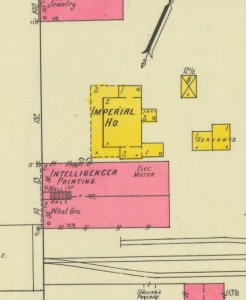City Directories and History: An early example of Anderson’s urban renewal was the razing of the Imperial Hotel, a early fixture of Anderson’s downtown. Demolition of the Imperial, formerly located at 134 North Main, began on May 3, 1914.
Standing for over 75 years, the Imperial Hotel was located on Main Street next door to the office of the Anderson Intelligencer. The hotel was originally the home of Fleetwood Rice, Anderson’s first railroad agent, and his wife, Lizzie Dean. The Rices sold the property and house in 1859, and moved to out west. The new owners turned the house into a hotel. Later it was the home for between 50 and 60 female students at Johnson University.

The Imperial Hotel (1911 Sanborn Fire Insurance Map detail)
There is no known image of the Imperial. The only description of the hotel comes from the Sanborn Fire Insurance Maps of Anderson. According to the maps, the hotel sat back from North Main. Across the front of the hotel was a long porch. The central portion of the house was two-story. Behind the hotel were a two-room servants quarters and a storage shed.
At the time of the dismantling, no one could give an accurate date as to when the Imperial had been built. The Rices has been in Anderson during the 1850’s, and given proximity of the house to the railroad line and Rice’s occupation with the railroad, indicate that the hotel was built sometime that decade. A century later, the hotel had been forgotten. The Anderson Independent wrote a history of hotels in Anderson on August 2, 1945, and the Imperial was not mentioned.

Edward Pinckney Vandiver, (Jr.), one of the last two owners of the Imperial Hotel. In 1905, E.P. Vandiver, Sr., lived at #312 N. McDuffie Street.
Before being dismantled, the Imperial had been vacant for some time. It was owned by two people: Mrs. D.S. Watson, the widow of the late Dr. Watson of Anderson, and Edward Pinckney Vandiver, Sr. (shown in photo). Since the hotel had been empty for some time, they decided to tear it down. Upon doing so, several things were discovered by curious onlookers. The Anderson Intelligencer of May 2, 1914, noted the beams which were used for rafters were round instead of the standard square shape. The beams were in excellent condition, almost as if they had just been installed, a testament to the craftsmanship of the day.
In its place was constructed a handsome two-story building that contained offices and retail spaces. Interest in the location was high because many of these spaces were rented before construction was even completed. This building remains today with its distinctive New Orleans style and “134” placed boldly on its facade, and has been the home of many businesses, including John B. Lee Record Store which had a listening room that was very popular in the 1960’s and 70’s.
Next door stood #132 North Main, the home of the Linley and Watson Company – Mr. John Linley and W.E. Watson; development, real estate and construction.
Stay Connected
Explore history, houses, and stories across S.C. Your membership provides you with updates on regional topics, information on historic research, preservation, and monthly feature articles. But remember R&R wants to hear from you and assist in preserving your own family genealogy and memorabilia.
Visit the Southern Queries – Forum to receive assistance in answering questions, discuss genealogy, and enjoy exploring preservation topics with other members. Also listed are several history and genealogical researchers for hire.
User comments welcome — post at the bottom of this page.
Please enjoy this structure and all those listed in Roots and Recall. But remember each is private property. So view them from a distance or from a public area such as the sidewalk or public road.
Do you have information to share and preserve? Family, school, church, or other older photos and stories are welcome. Send them digitally through the “Share Your Story” link, so they too might be posted on Roots and Recall.
Thanks!

